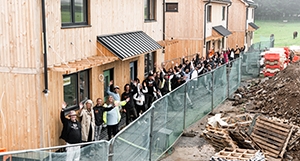Down to Earth Project
It is often said that complex problems require complex solutions. Down to Earth Project (DTE), a social enterprise based on the Gower peninsula of Wales, recognises and acts upon that need for complexity as it brings to life its vision of simultaneously tackling social inequality and environmental challenges to create equitable, thriving social and natural places.
Down to Earth Project’s focus is on delivering this goal through the medium of creating spectacular buildings with natural materials. Building on a 16-year track record of showing it is possible, and underpinned by 11 years of clinical research, DTE’s transformational and long-term change project - Fit for the Future - which was recently awarded £4,980,000 over ten years through The National Lottery Community Fund’s Growing Great Ideas programme*, will scale and replicate the approach they’ve developed across housing, health care and education infrastructure in Wales - and roll it out across the UK.

Going hand in hand, Down to Earth tackles social inequality and environmental inequality at the same time through a community-centred way of working which believes in people and believes in offering hope and possibility. They will construct buildings which are fit for the future in ecological terms, which are co-designed by their users - be they household residents, patients and hospital staff, or school children, and which can deliver healthcare and education services in the process of their design and construction. Underlying this process is DTE’s reflection on and commitment to working with the interconnectedness of health, the environment (both built and ‘natural’), and education to bring about social change.
“We are trying to change the perception that health care, education and the buildings with live and work in are all disconnected from each other, as well as separate from the natural environment. In reality, they are interdependent.” says DTE Co-founder and Director Mark McKenna.
DTE’s approach disrupts not only the way buildings are designed and constructed, but also their impact on those who build, live, work, learn, and are cared for in them.
Mark explains that “recent research in Wales shows 38% of hospital admissions are due to poor housing stock. There is a direct correlation between physical and mental health and quality of housing.” Through building higher quality housing and other buildings that people spend a great deal of their time in - such as schools and hospitals - DTE seeks to change this fact.
Building exclusively with natural materials and renewable technologies, construction on DTE’s builds is carried out by members of groups who are often excluded from society - such as young people labelled ‘NEETS’ (not in education, employment or training) people seeking asylum and those from refugee backgrounds, those experiencing mental illness and addiction, former offenders, and others. Through this process, participants gain accreditation in sustainable construction and green entrepreneurship, providing them with a route into employment. Not only that, but DTE has a strong evidence base of impact - underpinned by 11 years of clinical research undertaken with Swansea University - proving that this approach is as effective as antidepressants for treating those experiencing mental illness.
Through the buildings it constructs, DTE provides a more preventive, long-term approach to healthcare that nurtures both people and the planet and recognises the importance of environmental and contextual factors in health outcomes.
Building the Future
Over the coming years, DTE hopes to scale up and out, further complexifying and strengthening their ecosystem. Mark says that a major goal is to bring their model - which so far has primarily been applied to housing, community facilities and hospitals - to schools. To do this, they’ll need to spend the next few years creating frameworks for the delivery of a curriculum through school construction - engaging schoolchildren in the design and construction of their own school isn’t just a nice idea, but an opportunity for hands-on, holistic education. They will also need to develop relationships with Local Education Authorities to take this branch of the project forward.
DTE also hopes to take their model beyond the Welsh borders, with Mark expressing the desire to apply it in communities across England, Scotland and Northern Ireland. At the same time, Mark says they’re being wary not to rush, making sure they get things right before moving onto the next stage.
“We don’t want to make the mistake of growing the great idea too fast and getting it wrong,” he says. “We want to make sure there are solid foundations and a well-rooted system so that when we do scale and grow, we do so in a way that is robust, resilient and effective. It’s quite easy to grow and leave people behind, or forget about quality, or to sideline something critical to the mission.”
Ecosystem Building Blocks
Mark recognises that DTE can’t bring this dream to life all by itself. He explains that there are a range of actors across various and overlapping ecosystems who are crucial to the successful delivery of DTE’s ambitions around weaving together health, education, and the environment through the process of sustainable construction. They include health boards, LEAs, housing associations, local and national Government and further education institutions, not to mention the participants who actually carry out the construction work and the individual patients, staff members and students who co-design their places of residence and work.
Mark says that there are some branches of the ecosystem that are as yet still relatively under-developed, such as the networks pertaining to school infrastructure development, and individual builders - areas DTE will develop further over the coming years. Beyond that, he says they’ll need capital funding to access land for the homes they will build and the materials needed to construct the infrastructure they will co-create with communities across Wales and the rest of the UK.
What they most need, though, Mark says, is the opportunity to continue to prove their dream is possible.
“Everything we do builds on a track record of showing it is possible, which then gives people confidence it can work,” says Mark. “After completing a flagship residential centre with young people, housing association could see how we could build 6 houses. Now people have seen us do the houses, they see how we can build health care infrastructure, ls, once they see we can do hospitals they’ll be able to see we can do schools or prisons.”
Alan – a participant who experienced a traumatic brain injury and was part of DTE’s neurorehabilitation programme building homes with natural materials - testifies; “I had a head injury, I had no idea of coordination, I’d lost my coordination… doing this work now has helped me to coordinate myself with structures, tools and I’ve even got my driving license back and it’s given me that ability and that confidence… and making me able to do these things again has got me back on the path to living properly again which is marvellous for me.”
Learn more about Down to Earth's work, including the clinical research supporting their work and their blog with all the latest news. You can also follow them on Twitter or Facebook to keep up with their progress.
* Confirmed funding for three years, with funding after this to be agreed with our UK Funding Committee.
